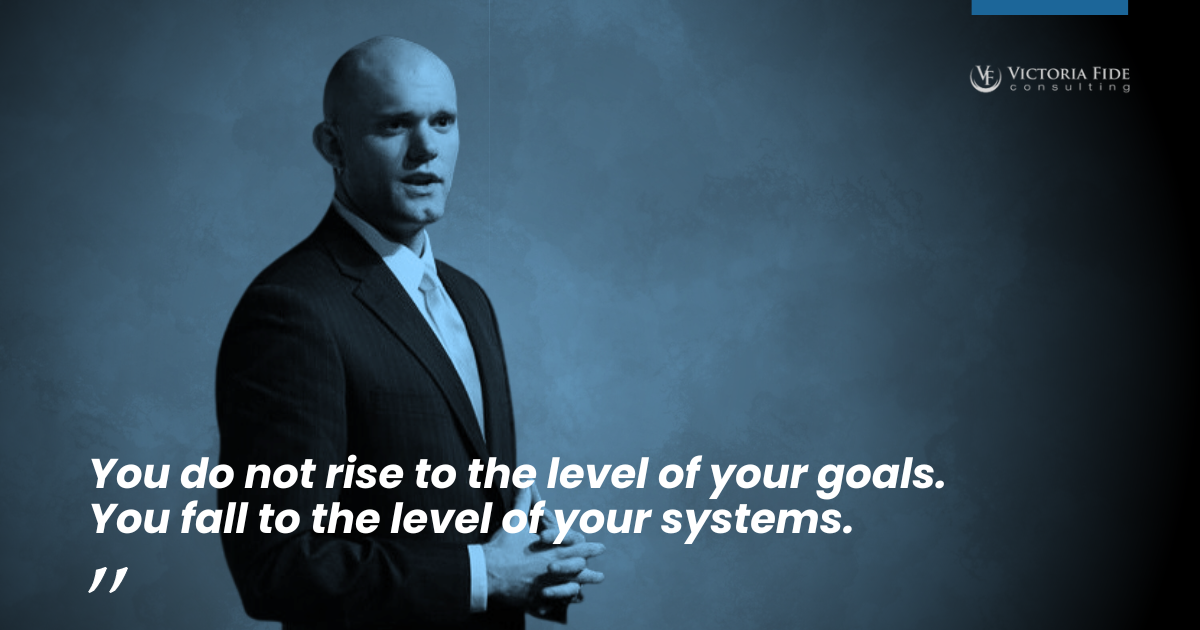
Rising to Excellence: How Operational Maturity Fuels DX Success
The Sage Wisdom series is produced by Victoria Fide Marketing with input and oversight from our leadership team and industry SMEs.
If having lofty goals were enough to reach the pinnacle of success, everyone would be living their dream lives. However, the reality is that simply having a goal is not enough. James Clear, the author of the wildly popular book Atomic Habits, argues that reaching your goal is less about focusing on the goal and more about structuring systems that will carry you to your goal.
James Clear is a renowned expert in habit building, decision making, and continuous improvement. Clear’s distinctive and highly effective communication style has earned him features in distinguished publications like Time magazine, the New York Times, and the Wall Street Journal. Additionally, he is a sought-after speaker for Fortune 500 companies, regularly sharing his expertise with companies such as Capital One, LinkedIn, McKinsey & Company, and many more.
In his bestselling book Atomic Habits, Clear writes, “You do not rise to the level of your goals. You fall to the level of your systems.” While Clear doesn’t undermine the power of setting goals to drive us, he emphasizes the importance of having effective systems to sustain us when motivation wanes.
This fundamental insight applies not only to personal growth but also to the grand ambitions of organizations. Companies may set lofty goals for the future, but operational maturity plays a pivotal role in whether those goals are realized or not. If an organization’s operational maturity is lacking, those transformational dreams might remain elusive.
In this article, we will explore the concept of operational maturity and its integral role in enabling organizations to achieve their digital transformation (DX) goals. We will also examine four strategies for increasing your organization’s operational maturity, setting it on the path to DX success.
Measuring Operational Maturity
Operational maturity is a general measure of the overall consistency, reliability, resilience, and coherence of an organization’s operations. To put it in Clear’s language, operational maturity is the level of your systems within the organization. Operational maturity typically falls into one of five broad categories: Ad Hoc, Repeatable, Defined, Managed, and Optimized. Let’s dive into each of these levels in more detail.
Ad Hoc: Unpredictable
At this operational maturity level, processes are unpredictable and subject to constant change based on user needs and situational factors. They lack control and operate reactively, leading to a chaotic and unstable work environment.
Repeatable: Consistent
Processes at this level occasionally yield consistent outcomes, but this requires strict discipline. They lack clear documentation, making automation and standardization challenging – if not impossible – to implement.
Defined: Documented
Processes are documented at this level, but these documents may not always reflect the current execution. In other words, the documentation isn’t always an accurate indicator of actual practices.
Managed: Monitored & Measured
At this maturity stage, processes are accurately documented and consistently followed. This allows process metrics to be used to monitor and measure the objectives across a range of operational conditions. Users demonstrate competence and adaptability in applying these processes in multiple and varied conditions, with repeatable and predictable results.
Optimized: Continuously Improving
In the highest level of maturity, the organization uses the process metrics to focus on continuous improvement by leveraging advanced techniques, data-driven insights, and a culture of innovation. This drive for excellence helps maintain a competitive edge within the industry.

Free PDF Download
In the rapidly changing digital landscape, more and more companies are desperately trying to keep up with the competition. Download “The 10 Biggest Mistakes Businesses Make in Digital Transformation” for free today to learn how to use DX to radically transform your business and gain an edge over your competitors.
The Connection Between DX Goals and Operational Maturity
The level of operational maturity determines the extent of transformational success. In cases where operational maturity falls within the bottom two levels, automation becomes nearly impossible due to difficulties in effectively communicating functional requirements to technologists. If the processes are defined yet not managed, any current documentation may not be accurate and will not communicate to technologists what the organization needs or expects the automated system to do.
As you can see, understanding your organization’s operational maturity level is vital before undertaking a DX initiative. While there are plenty of consultants that will charge a significant sum to assess your operational maturity level, individuals within the organization generally have an intuitive understanding of their operational maturity level. If they don’t, they can quickly assess it by asking managers to produce documentation for their relevant business processes and checking with the process users to verify if the documentation reflects their actual process execution.
Attempting to use technology as a solution for unpredictable and ill-defined processes is like trying to fix a leaky boat with a sieve. Organizations that undertake DX initiatives with a low operational maturity level risk implementing technologies that do not execute the necessary processes, and potentially even decrease functionality. To achieve a successful transformation, organizations should have an operational maturity level of Managed, with the aim of elevating maturity to Optimized through the transformational initiative.
Strategies for Increasing Operational Maturity
Elevating your organization’s operational maturity is a pivotal step in preparing for a transformational technology initiative, as it lays the necessary foundation for a more agile, effective, and cost-efficient project. To ensure your organization is ready to capitalize on all the potential benefits of a digital transformation, consider following four strategic steps:

Transformation is not easy, but it doesn’t have to be impossible. Take control of your project’s success today and schedule a free 30-minute consultation to find out how Victoria Fide can equip you for transformational success.
Step 1 – Assess
Begin by assessing your organization’s current operational maturity level to gain a clear understanding of your starting point. This evaluation is essential for charting your transformation journey effectively and identifying areas for improvement. You may choose to leverage external consultants or conduct an internal assessment.
Step 2 – Prioritize
More than likely, you will not be able to improve every area of your operations, so it is imperative to prioritize areas based on impact, available resources, and overarching organizational goals. Focus on areas that promise the highest returns, such as those closely tied to core business processes, customer experience, and opportunities for substantial cost savings and revenue growth.
Step 3 – Standardize
Wherever possible, Victoria Fide recommends adopting industry standards. These standards have undergone iterative refinement and optimization, and their efficacy has already been proven. Standardized processes provide a foundation for more cost-effective adjustments tailored to your organization’s unique selling points (USPs) rather than designing a solution from scratch.
Step 4 – Improve
Finally, focus on fostering a culture of continuous improvement within your organization. Empower your team to generate innovative ideas for optimization. Establish a functional feedback loop and encourage open communication and collaboration to drive ongoing enhancements. This commitment to improvement is central to maintaining operational excellence.
Once your organization attains a higher level of operational maturity, it signifies that your foundational processes are well-structured, consistent, and effectively managed. At this stage, you’re well-prepared to leverage digital transformation as a powerful tool for process optimization where you can strategically fine-tune and enhance your processes to boost efficiency, drive innovation, and maintain a competitive edge in your industry. In essence, you shift from a reactive approach to a proactive one, where digital transformation becomes an enabler of sustained excellence rather than a remedy for disorder.

The Imperative of Operational Maturity
In conclusion, the journey toward digital transformation (DX) success is intricately tied to the foundational concept of operational maturity. The sage words of James Clear, emphasizing the importance of effective systems in achieving goals, resonate not only in personal growth but also in the aspirations of organizations looking to technology to transform their operations. While lofty goals may inspire vision, it is the systems and processes that allow the organization to reach its intended objectives.
The five levels of maturity, from Ad Hoc to Optimized, provide a framework for organizations to gauge their readiness and chart a course for advancement. Organizations that grasp the critical link between operational maturity and digital transformation will prioritize laying a strong foundation before embarking on transformational endeavors. By pursuing the proactive steps of assessment, prioritization, standardization, and continuous improvement, they will attain a higher level of maturity.
As your organization attains a higher level of operational maturity, it signifies a shift from reactive problem-solving to proactive process optimization. It transforms DX into an enabler of sustained excellence, rather than a mere remedy for operational disorder, and sets the scene for technology solutions to optimize processes, enhance efficiency, drive innovation, and maintain a competitive edge.
Subscribe to our weekly LinkedIn Digital Transformation Success newsletter and get notified of each new edition.
